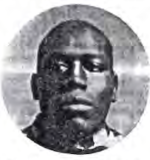 True Detective Mysteries, November 1933 In 1908, Reverend James Smith was preaching at a church in Reid’s Ferry, Virginia. He lived with Ernest Lyons, Lyons’ wife, and Lyons’ sister-in-law. Lyons helped Smith with the church and preached to the congregation when Smith was away. But tensions between the men arose when some members of the congregation began to prefer Lyons’ preaching to Smith’s. Smith also showed interest in Lyons’ sister-in-law, and Lyons warned Smith to stay away from her. On July 31, 1908, Lyons and Smith left the church together. They argued about the conference they would attend the next day. Smith had forty-five dollars that he collected from the church for the conference. According to Lyons’ testimony, Lyons and Smith parted ways shortly after they left the church. The next day at the church conference, Lyons showed up, but Smith did not. Lyons reported seeing Smith three times over the following weeks, although he later admitted that he had lied and said he saw Smith to quell church gossip. Lyons took over Smith’s position as pastor, but some members of the congregation were suspicious of the circumstances under which Lyons had assumed the role. Approximately three weeks after Smith disappeared, the body of a black man was found in the Nansemond River. The body was badly decomposed when it was pulled from the river and could not be identified. But the deceased man was wearing a suit suspiciously like the one Smith wore. One of Smith's friends also told investigators that if the body was Smith, he would have a gold ring on his right hand with a purple stone in it. When the body found in the river was examined, there was a ring on his right hand that seemed exactly like the one Smith always wore. In light of these circumstances, on November 6, 1908, the police arrested Ernest Lyons for the murder of James Smith. On January 13, 1909, Ernest Lyons’ trial began in front of Judge James L McLemore. Although Lyons protested that he was innocent, there was strong circumstantial evidence against him. Robert W. Withers, Lyons’ lawyer, tried to show that the body found was not Smith’s, but the prosecution had evidence of possible motive and the evidence that the clothes and ring on the corpse fit the description of those worn by Smith. The fact that Lyons had lied about seeing Smith in various places also did not help his case. Several parishioners testified against Lyons, telling the jury about disagreements between Lyons and Smith. The prosecution asked the jury for a conviction of first-degree murder, which carried the death penalty, but the jury, evidently convinced that Lyons had killed Smith after the two men fought again, convicted Lyons of second-degree murder. Lyons was sentenced to eighteen years in jail for the offense, Withers, Lyons’ attorney, was still convinced of Lyons' innocence and asked Judge McLemore to grant Lyons a new trial. When the motion was denied, Withers asked McLemore to rehear the motion. McLemore said that he would rehear the motion if Withers went to the jail where Lyons was held, told Lyons that his motion for a new trial had been denied, and asked him for the truth of the matter. When Withers asked Lyons for the truth about what had happened, Lyons told Withers that he had murdered Smith, just like the prosecution said. Lyons also said that he had not acted alone; the parishioners who testified against him had helped him dump Smith’s body in the river. Withers, upset by these facts, reported the conversation to Judge McLemore and had the parishioners implicated by Lyons arrested. The next morning, the alleged accomplices were brought into court where Lyons repeated his tale. After being asked to raise his right hand and swear, “If I have told a lie, may God strike me dead,” Lyons lowered his hand without saying anything. The parishioners were released. Lyons’ and Smith’s friend George E. Bunting remained convinced of Lyons’ innocence. Bunting believed that the corpse found in the Nansemond River was that of a passing vagrant who came up the river in a boat with another unknown man. The boat in question had been found with only one set of tracks leading away from it. Bunting investigated where Smith could have gone, without much success, until one day he received a letter telling him of a pastor in Wilson, North Carolina, who, even though he preached under another name, seemed to be James Smith. Bunting traveled to Wilson on March 31, 1912 and brought Smith back to Reid’s Ferry. Apparently, Smith had heard of the trial of his murder, but did not come back for fear that he would get in trouble for the forty-five dollars that he stole from the church. After Bunting presented Smith to Judge McLemore, Virginia Governor William Hodge Mann issued Lyons a pardon April 3, 1912, and Lyons was released after three years in prison. When Lyons was asked why he confessed to the murder after the trial, he said that he was angry that his parishioners turned against him and wanted revenge against them. – Researched by Susan Sperling |